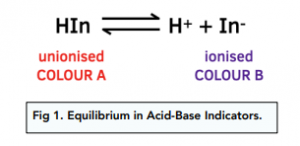Acids and Bases - Acid-Base Indicators (A-Level Chemistry)
Acid-Base Indicators
Indicators
An acid-base indicator is a substance that changes color over a specific pH range.
Acid-base indicators act as weak acids for which the unionised acid (HIn) and its conjugate base (In-) have different colours.
Unionised acid-base indicators and their ionised forms exist in an equilibrium.

When excess H+ from an acid is added, the equilibrium shifts to the left so that the number of unionised indicator molecules increases and color A predominates.
When excess OH- from a base is added, they react with H+ to form water. As H+ are used up, the equilibrium shifts to the right so that the number of ionised indicator molecules increases and color B predominates.
Choice of Indicator for Titrations
When you use an indicator:
• The colour change occurs at the equivalence point. The change in colour of the indicator needs to occur at the equivalence point of the titration.
• The indicator has a narrow pH range. The indicator chosen needs to cover a narrow pH range, that lies over the equivalence point.
• The indicator shows a sudden distinct colour change. An indicator should also need one or two drops to show a distinct colour change at the point of neutralisation.
The end point of the titration is the point at which the indicator changes colour. As indicators work over a small range of pH, it may not be exactly at the equivalence point.
The following graphs show which indicators are suitable for the three types of acid-base pH curves.

Summary Table of Indicators
Below is a summary table for choice of indicators for different types of titration:






Still got a question? Leave a comment
Leave a comment